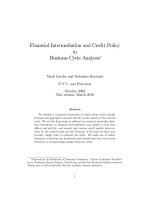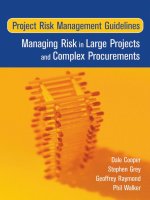Risk happens managing risk and avoiding failure in business projects
Bạn đang xem bản rút gọn của tài liệu. Xem và tải ngay bản đầy đủ của tài liệu tại đây (6.99 MB, 152 trang )
MIKE CLAYTON
RISK
Happens!
MANAGING RISK AND AVOIDING FAILURE
IN BUSINESS PROJECTS
Copyright © 2011 Mike Clayton
Published by Marshall Cavendish Business
An imprint of Marshall Cavendish International
PO Box 65829
London EC1P 1NY
United Kingdom
and
1 New Industrial Road
Singapore 536196
www.marshallcavendish.com/genref
Marshall Cavendish is a trademark of Times Publishing Limited
Other Marshall Cavendish offices:
Marshall Cavendish International (Asia) Private Limited, 1 New Industrial Road, Singapore 536196 • Marshall Cavendish Corporation, 99
White Plains Road, Tarrytown NY 10591–9001, USA • Marshall Cavendish International (Thailand) Co Ltd, 253 Asoke, 12th Floor,
Sukhumvit 21 Road, Klongtoey Nua, Wattana, Bangkok 10110, Thailand • Marshall Cavendish (Malaysia) Sdn Bhd, Times Subang, Lot
46, Subang Hi-Tech Industrial Park, Batu Tiga, 40000 Shah Alam, Selangor Darul Ehsan, Malaysia
The right of Mike Clayton to be identified as the author of this work has been asserted by him in accordance with the Copyright, Designs
and Patents Act 1988.
All rights reserved
No part of this publication may be reproduced, stored in a retrieval system or transmitted, in any form or by any means, electronic,
mechanical, photocopying, recording or otherwise, without the prior permission of the copyright owner. Requests for permission should be
addressed to the publisher.
The authors and publisher have used their best efforts in preparing this book and disclaim liability arising directly and indirectly from the
use and application of this book. All reasonable efforts have been made to obtain necessary copyright permissions. Any omissions or
errors are unintentional and will, if brought to the attention of the publisher, be corrected in future printings.
A CIP record for this book is available from the British Library
eISBN 978–981–4351–80–5
Cover design by OpalWorks
For my father, Gerald Clayton,
whose attitude to risk still affects my every decision.
Contents
Tables and Figures
Acknowledgements
Prologue
Introduction
Planning Out Risk
The Risk Management Process
Identify Risks
Analyse Risks
Plan for Risks
Take Action on Risks
Risk Monitoring and Control
Risk Resilience
Involving Stakeholders in Risk Management
The Psychology of Risk
Appetite for Risk
Risk Culture
Conclusion
Appendix A: List of Common Project Risks
Appendix B: Glossary
Appendix C: Learn More
Tables and Figures
Tables
Table 1.1
Table 2.1
Table 2.2
Table 3.1
Why Crises Happen
Estimating Techniques
Common Estimating Errors and Omissions
Variables of Scale and Complexity for Your Risk
Management Process
Table 3.2 Drivers of Scale and Complexity for Your Risk
Management Process
Table 3.3 Sample Roles and Responsibilities for Project Risk
Management
Table 3.4 Reasons for Documenting Aspects of Your Risk
Management Process
Table 3.5 Typical Contents of a Risk Management Plan
Table 4.1 Core Project Documents
Table 4.2 Typical Considerations for a Project Risk Potential Review
Table 4.3 Indicative Risk Kick-off Workshop Agenda
Table 4.4 Risk Identification Using Personal Experience
Table 4.5 SPECTRES
Table 4.6 Risk Categories
Table 4.7 Risk Register – Part 1
Table 4.8 Formal Description of a Risk
Table 5.1 Typical Descriptors for Likelihood
Table 5.2 Typical Probability Ranges for Likelihood
Table 5.3 Suggested Probability Ranges for Likelihood
Table 5.4 Suggested General Scales for Impact
Table 5.5 Suggested Scales for Schedule Impact
Table 5.6 Suggested Scales for Financial Impact
Table 5.7 Suggested Scales for Quality Impact
Table 5.8 Suggested Scales for Scope Impact
Table 5.9 Suggested Scales for Reputational Impact
Table 5.10 Suggested Scales for Health, Safety or Security Impact
Table 5.11 Suggested Scales for Environmental Impact
Table 5.12 Frequently Used Numerical Scale for Likelihoods and
Impacts
Table 5.13 Example of an Exponential Numerical Scale for Likelihoods
and Impacts
Table 5.14 Failings of Risk Scoring Systems
Table 5.15 Traffic Light Status Definitions
Table 5.16 (a) RMS Method – Risk 1
(b) RMS Method – Risk 2
(c) RMS Method – Calculation
(d) RMS Method – Results
Table 5.17 Risk Register – Part 2
Table 6.1 Tactics to Remove Project Risk
Table 6.2 Tactics to Reduce the Likelihood of Project Risk
Table 6.3 Tactics to Reduce the Impact of Project Risk
Table 6.4 Contingency Planning Process
Table 6.5 Elements of a Contingency Plan for Project Risk
Table 6.6 Risk Response Plan
Table 6.7 Risk Register – Part 3
Table 7.1 Risk Register – Part 4
Table 8.1 Leading Indicators of Project Risk
Table 8.2 Crashing the Timeline
Table 9.1 Scenario Planning Process
Table 9.2 Business Continuity Management Process
Table 10.1 The Stages of Resistance to Change
Table 10.2 Examples of Project Stakeholders
Table 10.3 Factors Affecting Stakeholders’ Attitudes to Risk
Table 10.4
Table 10.5
Table 11.1
Table 13.1
Table 13.2
Table 13.3
Table 13.4
Table 13.5
Table 13.6
Project Communication Strategy
Stakeholder Communication Plan
Typical Factors leading to a High Risk Project
Typical Benefits of a Strong Risk Management Culture
Elements of a Strong Organisational Risk Culture
Steps in Creating a Strong Organisational Risk Culture
Risk Management Maturity Levels
Lessons Learned Register
Post-Project Risk Review
Figures
Figure 1.1 Risk Mirror
Figure 1.2 Project Risk Management
Figure 2.1 Project Cost-Risk Profile
Figure 2.2 Time-Cost-Quality Triangle
Figure 2.3 Time-Cost-Quality-Scope
Figure 2.4 Scope
Figure 2.5 Risk Breakdown Structure
Figure 2.6 Scope Creep and Defining Scope
Figure 2.7 Work Breakdown Structure
Figure 2.8 Product Breakdown Structure
Figure 2.9 RACI Chart
Figure 2.10 PERT Estimates
Figure 2.11 Slippage in Highly Dependent Tasks
Figure 2.12 Islands of Stability in a Project Schedule
Figure 2.13 Cost and Organisational Breakdown Structure
Figure 3.1 The Risk Management Process/span>
Figure 3.2 Core Risk Management Documents
Figure 4.1 Periodic Review to Identify New Risks
Figure 4.2 Starting Place for Identifying Project Risks
Figure 4.3 SWOT Analysis
Figure 4.4 Fishbone Diagram
Figure 4.5 Fishbone Diagram – Stage 2
Figure 4.6 Process Decision Programme Chart
Figure 4.7 The Formal Structure of a Risk
Figure 5.1 Likelihood versus Impact Chart
Figure 5.2 Likelihood versus Impact Chart, with Scoring
Figure 5.3 Risk Dependency Map
Figure 5.4 Likelihood versus Impact Chart, with Colour Zones
Figure 5.5 Time to Impact versus Likelihood, with Bubble Size
Representing Impact
Figure 5.6 Time to Impact versus Complexity, with Bubble Size
Representing Impact
Figure 5.7 Likelihoods of 2 Independent Events, with Bubble Size
Representing Impact of Combined Outcome
Figure 5.8 Likelihoods of 2 Independent Events, with Bubble Size
Representing Impact of Combined Outcome
Figure 5.9 Decision Tree Example
Figure 5.10 The Beta Function
Figure 5.11 Examples of Statistical Distributions
Figure 5.12 The "Sleep at Night Test" Results
Figure 6.1 When to Do Risk Planning
Figure 6.2 Contingency Planning Process
Figure 6.3 More Research in Your Risk Management Process
Figure 7.1 Take Action on Risks
Figure 7.2 Consequential Risks Arise from Treating an Existing Risk
Figure 8.1 Risk Monitoring and Control
Figure 8.2 Earned Value Analysis
Figure 8.3 Risk Reporting – Scatter Plot
Figure 8.4 Risk Reporting – Trend Analysis
Figure 8.5 Risk Reporting – Category Analysis
Figure 8.6 Time-Cost-Quality-Scope
Figure 9.1 Scenario Analysis
Figure 9.2 Scenario Planning
Figure 9.3 Business Continuity Management
Figure 10.1 Predicted Efficiency Gains Following Project Handover
Figure 10.2 Observed Efficiency Gains and Losses Around Project
Handover
Figure 10.3 Stakeholder Management Process
Figure 11.1 Risk Appetite
Figure 11.2 Personality Driven by Attitudes to Uncertainty and
Consequences
Figure 11.3 Risk Managers in Context
Figure 11.4 Threat and Benefit Analysis for Potential Projects
Acknowledgements
I could not have written this book without the opportunities afforded me to manage projects and learn
about risk by colleagues at Deloitte Consulting, where I worked from the early 1990s until 2002. In
particular, I am grateful to Gilbert Toppin, Brian Green, John Everett, George Owen, Tricia Bey,
Chris Loughran and Richard Porter. I also gained valuable insights about risk from many other
colleagues – particularly Mark Warren, Charles Vivian and John Perry (whose article I rediscovered
in preparing this book).
There are also a number of project management bloggers whom I must thank for their insights.
Often, their thinking is at a level well above that of this book, so my apologies to them, if a whole
blog, or even series of blogs, has informed just one sentence, or simply the way I express an idea.
The details are important to me, so thank you in particular to Glen Alleman, Kailash Awati and John
Goodpasture.
I must also thank my wife, Felicity, who gave me the time to write this and read the manuscript
carefully, with the eye of a risk management novice – the readership for whom the book is intended.
She made me work just a little harder to explain what sometimes seemed obvious to someone inside
the industry.
Prologue
Eve is a 52-year-old woman living in Britain today. She attends a routine breast cancer screening at
her local hospital and is shocked to get a letter calling her back for further tests – her screening
results are positive. Eve urgently looks for information and finds plenty of facts on the Cancer
Research UK website. Around 260 out of every 100,000 women in the 50–55 year age bracket have
breast cancer. Screening will detect their cancer in around 85% of cases. In about 10% of all cases, a
positive result is a false reading and there is no cancer.
How worried should Eve be? In Eve’s place, most of us would be very worried indeed. Many
would rate Eve’s chance of having cancer at 70%, 80% or even 90%. This is a case of our intuitions
about statistical risk letting us down badly. Let us analyse the situation step-by-step, to understand the
real level of risk to Eve.
If 100,000 women in Eve’s age range are screened, we expect that 260 of them will actually have
breast cancer. The statistics tell us that 85% of those cancers will be detected – that is, 221 women.
Of the remaining 99,740 women who don’t have the cancer, 10% will receive a false positive result
on their first screening – this means 9,974 worried women with no cancer.
We are now ready to look at the important statistics. Of the 100,000 women who were tested,
10,195 of them were called back for further tests. That is, 221 women who really have breast cancer
and 9,974 who don’t. This means 221 out of 10,195, or just over 2% of the women called back will
have cancer. So Eve has a 1:46 chance of having breast cancer. This is worrying, but far from a
certainty, and more important for us, a long way from the level of likelihood that many people would
have estimated.
RISK RARELY MATCHES OUR INTUITIONS
Shift happens. Things go wrong in our lives, but neither our mental wiring, nor our basic education,
nor even the majority of our life experiences prepare us well to understand and handle risk. If Eve’s
case shows us anything, it is that we need to work hard to understand the level of risk we face; and
this is doubly so when we have choices about how to respond.
Increasingly, many of us are involved in making change happen – in our workplace, in our
communities and in our homes. Projects are becoming a way of life, and the faster we make change
happen, the more uncertainty we have to deal with. At the core of project management is the
management of risk. Risk Happens! is not a book about project management, but you will learn a lot
about project management from it. Risk Happens! is a book about managing project risk. For anyone
needing to undertake a new venture, this is essential.
Chapter 1
Introduction
IF YOU ARE MANAGING A PROJECT, then risk management is an essential part of your tool set,
and more and more of us are becoming project managers. This book is aimed at project managers in
private business, the public sector, the voluntary sector, local communities and in the home. I have
written it to be of value to the widest audience, from novices and students to experienced project
managers.
This book is not aimed at experienced managers of large scale capital projects or where severe
risks warrant advanced mathematical techniques and the highest standards of formality. If you have
been managing projects for many years and want to understand these advanced techniques, you will
need to look elsewhere, to more technical books. But before you do, please take a look at Risk
Happens! There is a lot in this book that may jog your memory, stimulate new ideas and refresh your
thinking.
For everyone who reads this book, you will gain a simple, powerful process for managing risk, a
big basket of tools to help you and some thought-provoking insights into the context of project risk and
how we respond to it.
WHAT IS PROJECT RISK?
A risk is something that may or may not happen. If it does happen, it will have an effect on your
project. So, the nature of risk is outlined in two concepts:
·
it is an uncertain event
·
it causes a change in your project.
Project risk is therefore uncertain events that can affect outcomes.
Notice that, in this definition, risk can introduce positive or negative changes. Whilst we often
think of risks as having adverse consequences, it can also present positive opportunities. Threat and
opportunity are like mirror images. This book will, of course, address the opportunities that harness
benefits, but it will focus mainly on the threat posed by risk.
Figure 1.1: Risk Mirror
A Hierarchy of Risks
When you consider the definition of risk and the task that project risk management faces, there is a
bewildering array of concepts. Don’t worry. They are easily distinguished, and even more
reassuringly, the distinctions rarely matter in the day-to-day practical task of managing your project
and getting things done. So let us look at three ways the term “project risk” can be used and examine
what we mean by each.
·
A project risk – This is an individual risk that can affect one part of your project.
·
Project risks – These are individual risks that can affect the whole of your project.
·
Project risk – This is the overall level of uncertainty of outcome for your whole project.
WHY IS RISK IMPORTANT TO PROJECT MANAGERS?
Project managers set out to deliver their products, services or change within pre-established
deadlines while facing the uncertainties inherent in a new project. Two things will help you in this
endeavour: plans and controls. When a project is under-planned and poorly controlled, it will surely
fail.
Plans and Controls
Plans set out how you intend to deliver your project. They address the three project elements: tasks,
time and resources; and describe what needs to be done, how it will be done, when, by whom, with
what assets and materials and how it will be paid for. Sadly, the uncaring universe will not respect
your plan. US President Eisenhower is credited with the dictum: “Plans are worthless, but planning is
everything.” The truth of this statement is well-known to all project managers.
Controls establish two things: how you propose to stick to your plan in the face of the challenges
of the real world, and what you will do when reality forces your project to deviate from plan. Risk
management is, perhaps, the most important of your project controls.
Crises happen when we cannot respond effectively to a threat. They are rarely due to a lack of
plans or processes. Rather, they tend to be the result of overconfidence and complacency. Table 1.1
sets out some examples.
More Reasons Why Projects Fail: Strategic Risk Factors
Over the years, many organisations have researched the risk factors that indicate potential project
failure. They do this by surveying failed projects and asking those involved or external observers for
their assessment of the reasons for failure. The reasons that emerge have a depressingly familiar ring
to anyone who has spent much time working in an organisational context. Here are the top 10 risk
factors, in no particular order. This book will address all of these risks.
1.
The project goal and objectives are either unclear, or are disconnected from the
organisation’s other priorities, leading to a weak case for change.
2.
People have unrealistic expectations, leading to a determination of failure despite the
project meeting its goal and objectives.
3.
Senior people in leadership roles fail to accept responsibility for the project, and do not
give it the support, commitment and leadership it needs. This often leads to an over-reliance
on consultants or outside contractors.
4. People resist the changes that the project brings or resist participating in the process, often
because their role in the project’s success is undervalued by the team.
5.
Project management, change management, stakeholder management and risk management
skills are lacking.
6.
The project is poorly planned, without a sound basis for estimates of schedule and
resources, leading to unrealistic deadlines or budget.
7.
Key elements of the project are not controlled effectively, such as changes to scope or
functionality, delivery or quality of products, or deviations from plan.
8.
There is too much focus on cost – or price of contracts – and not enough on the balance
between cost and risk/value.
9.
A project solution is defined before adequate research has validated that it is technically
possible, organisationally desirable and free of unintended consequences.
10. Project overload – the organisation is simply trying to do too much with the resources that
it has available.
WHAT IS PROJECT RISK MANAGEMENT?
Since all new projects involve, by definition, novelty, innovation and change, there will also be many
uncertainties. So project managers have developed ways to maximise control where possible, and
minimise the areas where we have no control. Project risk management consists of three things:
1.
Processes, systems and procedures that try and make the project more predictable, and
bring rigor and accountability to the way we manage uncertainty and its consequences.
2.
Tools, techniques and methods that help us understand and deal with the real world, dayto-day.
3.
Attitudes, values and perspectives that allow us as humans to cope and to overcome our
instinctive responses to uncertainty and crisis.
Management is the Discharge of Responsibility
It is important that we accept that no form of risk management can eliminate all risks. But it is also
true, as Peter Bernstein says in his book about the history of financial risk, Against the Gods: “If
everything is a matter of luck, risk management is a meaningless exercise.” If we believe too much in
the power of luck, it relieves us of responsibility. With good risk management you cannot prevent
shift from happening, but you can reduce the frequency and scale of adverse events.
Figure 1.2: Project Risk Management
AN OVERVIEW OF RISK HAPPENS!
Risk Happens! will provide you with a comprehensive overview of all of the aspects of project risk
management.
Chapter 2: Planning Out Risk
Risk management begins with building a robust plan that reduces your risk from the start. Chapter 2
looks at how to define a project with clarity and precision from the outset, and explores the principal
project planning tools that allow you to address the key areas of risk: scope, schedule, resources and
quality.
Chapter 3: The Risk Management Process
Chapter 3 is the keystone that holds the arch of this book in place. It sets out a fundamental four-stage
process for managing project risk and sets that process in an organisational context. You will learn
how this process can be scaled for any size of project and level of risk, and discover what are the
roles and responsibilities that go with risk management.
Chapter 4: Identify Risks
This chapter will give you a host of techniques to identify project risks by examining the key risk
impact areas of quality, scope, schedule and resources, as well as the sources of risk. It includes tips
on conducting a project risk workshop and assessing your overall project risk. This chapter will also
introduce you to your primary risk management tool, the risk register, and how to describe a risk
formally.
Chapter 5: Analyse Risks
Learn how to understand, evaluate, categorise and prioritise the risks you have identified. What risks
can you safely ignore and what risks should you focus on? You will learn about how to assess risks
qualitatively and quantitatively, and ways to illustrate risks to your colleagues and stakeholders.
Chapter 6: Plan for Risks
There are six principal strategies for managing risk, which you can combine into thousands of
detailed approaches. This chapter looks at these six strategies and gives examples of how to apply
them.
Chapter 7: Take Action on Risk
The commonest mistake risk managers make is to pay insufficient attention to actively managing risk.
This chapter shows you how to focus on practical steps to reduce risk day-to-day. Success requires
persistence, so closing the loop in reviewing the outcomes of your actions is vital.
Chapter 8: Risk Monitoring and Control
Complete control requires an active approach to observing what is going on and updating your
understanding frequently. In this chapter you will learn about the monitor and control cycle and
different ways to respond to problems or opportunities that arise. Another important part of the cycle
is ongoing project assurance. Finally, you need to keep others fully informed, so this chapter will also
discuss reporting.
Chapter 9: Risk Resilience
Don’t just try to avoid risk, build resilience so that you can handle it – even when a perfect storm of
risks manifests. This chapter will introduce the disciplines of scenario planning, contingency planning
and disaster recovery.
Chapter 10: Involving Stakeholders in Risk Management
Your stakeholders will determine the success – or otherwise – of your project. This chapter shows
you the basic tools for involving your stakeholders in a dialogue about project risk.
Chapter 11: Appetite for Risk
How you manage risk will depend on how much risk you are prepared to accept. This chapter
explores the strategic aspects of risk management and gives you the tools to prioritise which projects
you undertake by reviewing their potential risk and return.
Chapter 12: The Psychology of Risk
Your perception of risk is never objective. A host of psychological factors determine the way we
perceive and respond to risks; this chapter explores both individual and group biases.
Chapter 13: Risk Culture
The last chapter looks at the decision making, oversight and policy infrastructure that needs to
surround your project. Learn how to incorporate organisational learning into your plan, how to
identify lessons from your project, and the basic foundations for building a risk-aware and riskresponsible culture.
Chapter 2
Planning Out Risk
PROJECT RISK MANAGEMENT must begin with taking steps to avoid the risks that
you can avoid. A clear definition of what your project is – and is not – will avoid unnecessary
confusion, and it will form a firm foundation for planning your project.
The second fundamental is to plan your project to remove or reduce the risks you can. At this
stage, you will start to face some real choices in how to specify and conduct your project; trading cost
for certainty. Figure 2.1 shows how different project solutions typically offer different levels of risk.
Your planning process must explicitly choose from among those options.
Figure 2.1: Project cost-risk profile
This chapter will give you an introduction to aspects of the definition and planning phases of a project
and will offer you a range of ways that you can address scope, schedule, budget and quality risks by
the way you plan your project.
PROJECT DEFINITION
Project risk can be defined as uncertainty that can affect outcomes, so your first step in reducing risk
is to remove uncertainty. In the earliest stages of your project, start by working hard to remove
uncertainty about your project’s goal and objectives by consulting widely, then defining and
documenting them as clearly and unambiguously as you can.
Step 1: Project Goal
Your project goal states what the project is designed to achieve. The reason for commissioning – or
at least considering – your project should therefore be self-evident from your goal. Whilst broad
consensus among the project commissioners and clarity of language are the most important things, it is
also helpful to craft the wording of your goal so that it creates an enticing prospect for the people you
will want to engage as team members, collaborators and supporters.
Step 2: Project Objectives
Once you have a goal agreed, your next negotiation will be to set the project’s objectives. These
define the measures of success that you will apply to achieve your goal. These are typically measures
of:
·
Time
Completion targets that can be anything from loose ambitions (“to be completed over the next
three years”) to tight deadlines (“to be fully operational by 1 July 2015”).
·
Cost
Cost covers financial and other resource costs, such as people, assets and material. These can
all be traded for money.
·
Quality
Quality will come to the fore when safety is an issue on your project, and also where the
reputation of the project’s promoter is linked to the success of the project.
Time, cost and quality form the project management Time-Cost-Quality Triangle.
Figure 2.2: Time-Cost-Quality Triangle
The Time-Cost-Quality Triangle is a powerful tool for a project manager. Right from the outset,
having determined your sponsor’s objectives, find out where on this triangle their priority lies. It
might, as in Figure 2.2, lie between the time and quality values, suggesting that quality is their first
concern. You must work hard to deliver this, and once you have delivered this, you must focus on
delivering to schedule. Only then, do you seek to optimise the cost.
Notice how these three corners constrain one another. Once your sponsor has set objectives for
time and quality and you have calculated an optimum budget, the three corners of your triangle come
into balance.
If your sponsor wants the project delivered earlier than planned, you can only do so by committing
more money or resources, or by cutting corners on the quality. If they want a higher specification, it
will take you longer and cost more. And if they want to drive down cost, you can only do so by
compromising quality or taking longer. Alternative names for this triangle are the Triangle of
Balance or the Triple Constraint.
Your ability to trade off one constraint against the others effectively is wholly dependent upon
everyone concerned having a shared understanding of the definition of your project.
Step 3: Project Scope
Shift happens and things will go wrong on your project. The wise project manager will build
contingencies into their allowances for time-schedule, cost-budget and quality-specification, to allow
for problems. But there may also come a time when you run out of contingency… Happily, there is a
fourth corner to the Time-Cost-Quality Triangle!
Figure 2.3: Time-Cost-Quality-Scope
Scope is not about the quality of the assets, products, services or processes your project produces; it
is about the quantity. Scope measures how much you plan to deliver. If you run out of time and budget,
and cannot cut corners, what remains is your ability to deliver less than originally planned. Scope is a
key concept for project managers. If you start your project knowing which elements of scope are of
least value to your sponsor, then, when trouble arises, you may be able to scale back aspects of the
project without damaging your core goal.
Scope is most easily represented by a boundary. Everything inside this boundary is “in scope” –
this is the project’s task and the project manager’s responsibility. Everything outside the boundary is
“out of scope”.
Figure 2.4: Scope
After you have defined you project goal and objectives, the third essential step is defining and
agreeing among key people what the scope of your project is and is not.
A Breakdown of the Risks
One of the most powerful tools for identifying risks is to break down all of your project risks
according to a fixed set of risk categories. Time, cost, quality and scope offer us one of the most
useful ways to identify project risks and we will use these categories to help us to plan out some of
the major project risks you are likely to encounter. Presenting risks as a hierarchy in this manner
gives us what is known as a Risk Breakdown Structure – sometimes abbreviated to RBS.
Figure 2.5: Risk Breakdown Structure
We will address some of the major risks shown in the example RBS in Figure 2.5.
PLANNING OUT SCOPE RISKS
One of the biggest risks projects face is “scope creep”. This is the tendency for people to bundle
additional work into your project and so get their objectives met using your budget, resources and
effort. The danger of this is evident: in using your resources to meet my objectives, you will
compromise your ability to meet your own objectives.
The commonest cause of scope creep is not malice, stupidity or opportunism; it is simply
confusion. If the boundary of your scope is not clearly delineated, I may assume that what I want is in
scope, whilst you, with equal merit, assume it is out of scope. Defining the boundary with precision is
a vital first step to fixing your scope and managing this aspect of risk.
To make your boundary as precise as possible, you must define not just what is in scope, but
equally, what is out of scope. This requires you to use your experience – and that of your team – to
foresee where scope misunderstandings are likely to occur.
Figure 2.6: Scope Creep and Defining Scope
The second step is to get the precise definition of the project’s scope signed off by your project
sponsor, so that you have an authoritative voice supporting you when you resist pressures to expand
the scope. With your scope defined, let us examine some powerful tools that will help you further
manage scope risk: the Work Breakdown Structure (WBS), Product Breakdown Structure (PBS) and
the RACI chart (see below).
Defining the Work and Deliverables
To move from a scope statement to a plan in your project definition, you will need to articulate your
project activities and deliverables item-by-item. The tools that will allow you to do this are the WBS
for setting out your activities, and the PBS for setting out your project deliverables, or products.
Whichever you use is a matter partly of circumstance and partly of preference. It can also be the result
of culture and training. In the United States, the Project Management Institute (PMI) uses the term
WBS for a breakdown of products rather than activities. Projects that deliver complex assets are far
more likely to benefit from a PBS, whilst organisational projects with few and simple physical
deliverables will usually prefer a WBS.
Work Breakdown Structure (WBS)
Figure 2.7 illustrates a WBS for creating an opening ceremony for a new village hall. Here, it is the
tasks that are represented in the boxes, and these can be allocated a cost to create a project budget, as
well as people to do them, to create a project organisation chart. (We will see in Chapter 4 how you
can use your WBS to identify specific project risks.)
Figure 2.7: Work Breakdown Structure
Product Breakdown Structure (PBS)
Figure 2.8 shows an illustrative PBS for a project involving fitting a new kitchen. It shows how each
component that has to be sourced or fabricated can be assigned a unique PBS number or product
reference. This allows project managers to document specifications and quality standards for each
product and track delivery, and sign-off against the standards.
Figure 2.8: Product Breakdown Structure









